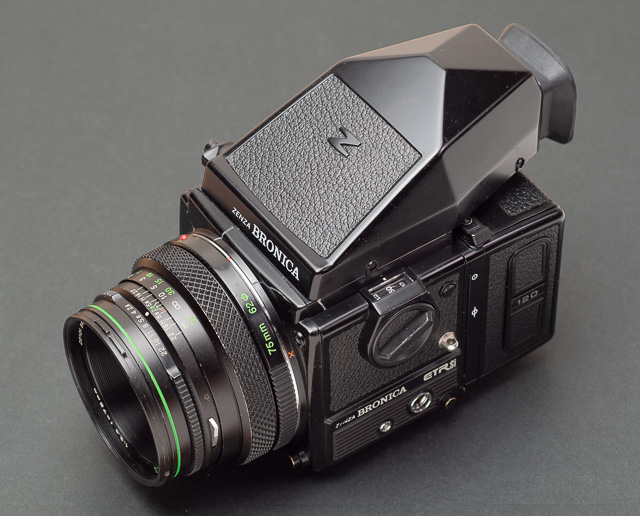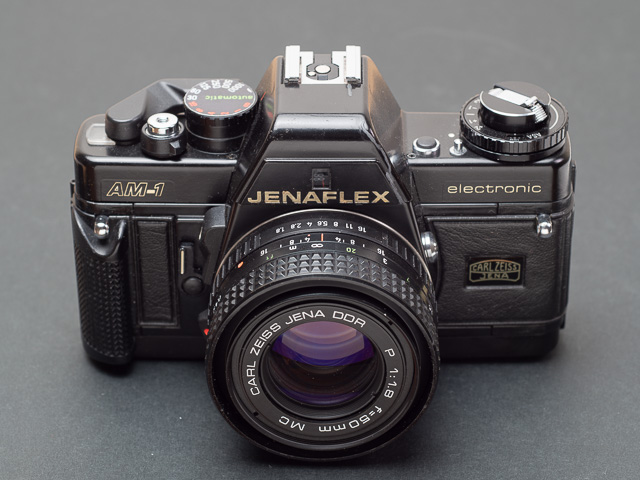JeffS7444
Well-known
I've been intrigued with the idea of Japanese "kintsugi" repairs in which the repaired items (usually cracked ceramics) gain a sort of imperfect beauty because of, not despite these repairs. With these camera repairs, I did not attempt to use traditional materials such as urushi lacquer mixed with rice flour, because I'm not so familiar with their properties and I don't know how suitable they would be for mending cameras. But on the other hand, I do have a pretty good sense of what modern epoxies are capable of, and what follows are my first attempts at kintsugi-style repairs using non-traditional materials.
Cracked battery cover on Superheadz Digital Harinezumi mended with clear JB Weld epoxy mixed with powdered gold:

Cracked battery cover on Superheadz Digital Harinezumi mended with clear JB Weld epoxy mixed with powdered gold:

JeffS7444
Well-known
Bronica ETRSi camera body mended with JB Weld steel-reinforced epoxy, left in it's natural gray color:




JeffS7444
Well-known
Jenaflex AM-1 crack on left hand side of pentaprism mended with JB Weld (gray) and left in it's natural state. Missing portions of "Jenaflex" lettering filled in with powdered gold:


charjohncarter
Veteran
Does that WELD dry out or do the two tubes make it last longer?
Pál_K
Cameras. I has it.
Interesting concept. I like it.
“Kintsugi (金継ぎ, "golden joinery"), also known as kintsukuroi (金繕い, "golden repair"), … is the Japanese art of repairing broken pottery by mending the areas of breakage with lacquer dusted or mixed with powdered gold, silver, or platinum, a method similar to the maki-e technique … As a philosophy, it treats breakage and repair as part of the history of an object, rather than something to disguise.”
https://en.m.wikipedia.org/wiki/Kintsugi
Also:
“In traditional Japanese aesthetics, wabi-sabi (侘寂) is a world view centered on the acceptance of transience and imperfection.”:
https://en.m.wikipedia.org/wiki/Wabi-sabi
“Kintsugi (金継ぎ, "golden joinery"), also known as kintsukuroi (金繕い, "golden repair"), … is the Japanese art of repairing broken pottery by mending the areas of breakage with lacquer dusted or mixed with powdered gold, silver, or platinum, a method similar to the maki-e technique … As a philosophy, it treats breakage and repair as part of the history of an object, rather than something to disguise.”
https://en.m.wikipedia.org/wiki/Kintsugi
Also:
“In traditional Japanese aesthetics, wabi-sabi (侘寂) is a world view centered on the acceptance of transience and imperfection.”:
https://en.m.wikipedia.org/wiki/Wabi-sabi
JeffS7444
Well-known
Mixing the resin and hardener triggers a chemical reaction which causes the epoxy to harden. There's no solvent involved, so the unmixed components do not dry out in the usual sense.Does that WELD dry out or do the two tubes make it last longer?
Rayt
Nonplayer Character
Do the words duct tape sound better in Japanese?
agentlossing
Well-known
I like the effect!
peterm1
Veteran
I've been intrigued with the idea of Japanese "kintsugi" repairs in which the repaired items (usually cracked ceramics) gain a sort of imperfect beauty because of, not despite these repairs. With these camera repairs, I did not attempt to use traditional materials such as urushi lacquer mixed with rice flour, because I'm not so familiar with their properties and I don't know how suitable they would be for mending cameras. But on the other hand, I do have a pretty good sense of what modern epoxies are capable of, and what follows are my first attempts at kintsugi-style repairs using non-traditional materials.
Cracked battery cover on Superheadz Digital Harinezumi mended with clear JB Weld epoxy mixed with powdered gold:

"I've been intrigued with the idea of Japanese "kintsugi" repairs in which the repaired items (usually cracked ceramics) gain a sort of imperfect beauty."
Yes, me too - the essence of Wabi Sabi. I too have experimented with kintsugi - though only with ceramics, not with cameras. That is something that would not have occurred to me. Though - nice job. I too have experimented with using modern epoxies. Instead of actual gold I bought from an art supply house, powdered bronze. It works quite well but does seem to need sealing to prevent it from tarnishing. In my early experiments I mixed the bronze powder with the epoxy. But I now think that with my next attempt I will do what the Japanese do - use the glue first (as you point out they use a urushi base to which is mixed rice paste glue which gives it some needed properties and sets up more quickly. I have seen the correct proportions and techniques somewhere on the internet so the info is needed on how to do it traditionally. But urushi is difficult to use, slow to dry and even more difficult to handle as it causes severe contact dermatitis (the tree from which it comes is related to poison oak).
I have found the best epoxy to use is one that sets clear and has a 30 minute hardening time. 5 minute epoxy sets up too quickly and 24 hour epoxy too slowly. Unfortunately the 30 minute epoxy is hard to find.
As I was saying above, I also plan that with my next attempt I will not mix the powder with the glue, but instead I will apply the glue carefully leaving a small bead / line of it at the surface and then sprinkle the powder onto the still tacky glue using a tsutsu tube (example here): https://shop.korest.de/URUSHI-ART/S...-tube-size-7-red-tsutsu::357.html?language=en)
No need to buy a tsutsu tube - all you need is a small diameter tube (e.g. bamboo or it could even be aluminium or copper etc) with one end covered with mesh from a nylon stocking or similar. It is a kind of sprinkling device used by Japanese in their "Maki" technique. When the glue line has set, by then it should have the gold colored powder embedded in it and any "over spray" from the tsutsu tube should be able to be washed off (unless there have been glue over runs and this contaminates the surface you are working on making it sticky.) That's more or less my theory anyway. The precise Japanese technique using urushi and actual gold is slightly more refined as you might expect. But I am one who loves to learn and adapt old techniques so I can use them on with new materials.
peterm1
Veteran
Another thing I forgot to mention is that to undertake kintsugi and make the technique (a) a bit easier and (b) approximate the Japanese technique it would be useful to first use a fairly quick setting glue to glue pieces together - this is especially beneficial if as with ceramics there are often parts that have not merely cracked but have broken off completely. A quick set glue means no difficult to use and fiddley jigs are needed to hold parts in alignment while the glue sets. The new hi tech UV activated glues could be excellent for this purpose.
The Japanese use urushi of course which does not have quick setting properties but my point is they use a 3 step approach to kintsugi - they first glue the parts back together, then they clean any over runs after the glue has set (by scraping etc) then they apply a new bead of urushi over the glue line / repaired crack then while tacky sprinkle it with finely granulated gold dust.
The Japanese use urushi of course which does not have quick setting properties but my point is they use a 3 step approach to kintsugi - they first glue the parts back together, then they clean any over runs after the glue has set (by scraping etc) then they apply a new bead of urushi over the glue line / repaired crack then while tacky sprinkle it with finely granulated gold dust.
JeffS7444
Well-known
Thanks for that link, Peter, it seems like a more reputable source for powdered gold than random sellers on Amazon.
Perhaps you've already seen this, but I just discovered this site + accompanying videos, which cover the gamut from easy epoxy repairs, to more traditional materials:
https://www.kintsugioxford.com/
I figure the idea for these repairs had been vaguely brewing in my mind for years, influenced by the DIY cameras from Lomography, painted cameras sold as art objects by Ukrainian eBayers, the Sandbenders computers from William Gibson's novels, and any number of documentaries produced by NHK. It also seemed like a handy way to turn a pile of junk into something appealing once again.
Wabi-sabi? I have only a rudimentary sense of what it's about; how deep does that particular rabbit-hole go?
Perhaps you've already seen this, but I just discovered this site + accompanying videos, which cover the gamut from easy epoxy repairs, to more traditional materials:
https://www.kintsugioxford.com/
I figure the idea for these repairs had been vaguely brewing in my mind for years, influenced by the DIY cameras from Lomography, painted cameras sold as art objects by Ukrainian eBayers, the Sandbenders computers from William Gibson's novels, and any number of documentaries produced by NHK. It also seemed like a handy way to turn a pile of junk into something appealing once again.
Wabi-sabi? I have only a rudimentary sense of what it's about; how deep does that particular rabbit-hole go?
peterm1
Veteran
Thanks for that link, Peter, it seems like a more reputable source for powdered gold than random sellers on Amazon.
Perhaps you've already seen this, but I just discovered this site + accompanying videos, which cover the gamut from easy epoxy repairs, to more traditional materials:
https://www.kintsugioxford.com/
I figure the idea for these repairs had been vaguely brewing in my mind for years, influenced by the DIY cameras from Lomography, painted cameras sold as art objects by Ukrainian eBayers, the Sandbenders computers from William Gibson's novels, and any number of documentaries produced by NHK. It also seemed like a handy way to turn a pile of junk into something appealing once again.
Wabi-sabi? I have only a rudimentary sense of what it's about; how deep does that particular rabbit-hole go?
Wabi sabi as a concept I find to be somewhat in keeping with the very British upper class love of extremely old and high quality but very ratty and tatty, worn old armchairs and old gilded mirrors with tarnished and worn mirroring above an open fireplace that has a smoke stained chimney piece with paintings on either side that were painted by Holbein but are so stained by the centuries that they are hardly discernable. Well you get the idea.
If you think that means I do not like wabi sabi then you would wrong - especially in the Japanese incarnation which is very much influenced by Zen and is quite sublime and subtle, and deeply rooted in the Zen idea of impermanence and acceptance of imperfection. Perhaps I like wabi sabi because as I grow older I find myself to be more wabi sabi in my own appearance
I kind of like this article about wabi sabi which explains it rather well.
https://www.tofugu.com/japan/wabi-sabi/
And this selection from Pinterest gives some visual idea of it (at least in relation to interior decoration)
https://www.pinterest.com.au/search...Al43BtGSRxEnnhNVjcHD1MJGPk&source_id=RTVnhOlZ
Share:
-
This site uses cookies to help personalise content, tailor your experience and to keep you logged in if you register.
By continuing to use this site, you are consenting to our use of cookies.
